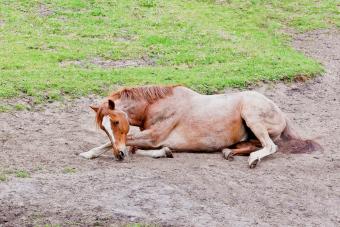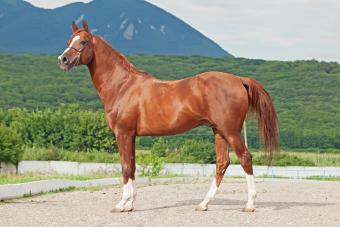
Colic is a critical condition that can affect horses of any age or size. As a horse owner, it's essential to understand the causes, symptoms, and treatment options for colic in horses. The ability to identify the early signs and act quickly will ensure the best outcome for your horse.
What Is Colic in Horses?
Equine colic is a broad term used to describe abdominal pain in horses, typically associated with gastrointestinal (GI) problems. Nearly 50 percent of equine veterinary visits involve colic symptoms. A horse may experience colic due to gas buildup in the intestines, an intestinal blockage, or intestinal torsion.
Occasionally, colic may resolve on its own. However, in many cases, the symptoms will progress if left untreated and can be life-threatening.
Unique Horse Digestive Anatomy
Horses are naturally susceptible to colic as a result of their organ function and body composition. Within a horse's unique digestive tract, they possess a fermentation system designed to optimally break down food. This fermentation results in the production of gas, which can build up within the intestinal tract if things are not able to move normally.
Horses cannot burp to relieve the pressure of gas buildup because of their physiology. Their esophageal sphincter, the ring of muscle where the esophagus and stomach meet that allows food to go down, is incredibly strong and developed. It does not allow food, liquid, or gas to come back up the esophagus, so a horse's digestive tract is essentially a one-way system.
Additionally, their anatomy puts horses at high risk for intestinal torsions. Unlike humans, whose intestines are secured in place within the abdomen, the entire digestive tract floats freely inside a horse. Equine intestines can easily twist and prevent the movement of contents such as gas, food, or foreign materials.
Common Causes of Colic
Various factors can contribute to this condition. It is important first to understand the common causes of colic and take any possible precautions. While some causes of colic may be avoidable, others are not.

Sand Ingestion
Horses that eat from the ground or reside in areas with sandy soil are at risk for colic secondary to sand ingestion. These sand particles can irritate the inside of the intestines or even create a blockage if enough accumulates. A slow feeder designed to reduce spillage can help minimize the amount of sand your horse ingests and protect them from sand colic.
Foaling
Mares are susceptible to colic just before, during, and following giving birth. Because the intestines float freely within the abdomen, the colon has an increased likelihood of twisting on itself. This torsion can obstruct the movement of gastric contents and eventually cut off blood supply to the tissues.
Abrupt Diet Changes
If your horse's diet changes abruptly, they can experience colic. If you elect to switch your horse's food, be sure to transition them slowly over several weeks.
Worm Infestation
Intestinal parasites such as tapeworms, roundworms, or bloodworms can contribute to colic. These worms can cause damage to the intestines or they can form an intestinal blockage in a severe infestation. Routine deworming under the guidance of your veterinarian can help prevent these concerns.
Low Water Intake
Horses who don't have appropriate access to water can become dehydrated. Without adequate water to move intestinal contents along, hay and dry forage can collect and obstruct the GI tract. To prevent this, ensure ample water is always available to your horse.
Colic Signs and Symptoms
Regardless of the cause, colic often presents in the same way. These symptoms can range in severity from mild to serious. Horses with colic appear uneasy and make every attempt to find a comfortable position to minimize their pain. Some of the most commonly observed signs of colic include the following:
- Loss of appetite
- Depression
- Less frequent bowel movements
- Lip curling
- Elevated heart rate
- Agitation
- Turning head repeatedly toward sides
- Pawing or biting at the abdomen
- Stretching out repeatedly
- Laying and rising repeatedly
- Frequent repositioning
- Lying on back
- Violent thrashing
- Repeated rolling
Take Immediate Action
If your beloved horse displays any symptoms of colic, it's critical to act quickly. Phone your veterinarian right away to report the behaviors and describe them in detail. It can be beneficial to capture a video of your horse to show the vet precisely what they are doing.
Lead your horse to an area or enclosure where you both are safe from injury. A horse in pain may unintentionally harm themselves or those around them while thrashing or rolling. Remove any hay or feed from their surroundings.
How Is Colic Diagnosed?
Your veterinarian will obtain vital signs and perform a complete physical exam on your horse to determine if it has colic. This assessment should give them the information they need to diagnose your horse, although they may recommend additional diagnostics such as blood work, radiographs, or ultrasound. They will also determine the severity level of the colic and take appropriate action to help your pet.
Treatment Options
There are generally two routes of treatment that your veterinarian will recommend based on the cause and severity of the colic.

Medical Treatment
Horses with mild-to-moderate colic typically respond very well to medical treatment. If there is significant gas or gastric fluid buildup, your veterinarian may pass a stomach tube to alleviate the pressure. This is done while horses are awake and can provide them with enormous relief.
They will then likely prescribe medications to ease the pain and promote digestive motility. Intravenous fluid therapy might also be warranted if they are dehydrated. However, if your horse does not seem to improve with the prescribed plan, call your vet for a re-examination. They may need to pursue another type of treatment option.
Surgical Intervention
Unfortunately, in some cases, surgical intervention is the only solution to resolve colic. This may be the case if medical treatment is unsuccessful or if the vet suspects an intestinal torsion. Surgery is warranted in 2 to 10 percent of horses seen with colic. Your horse will probably travel to a surgical facility where they will undergo general anesthesia. During surgery, the veterinary team may remove any persistent blockage, rearrange twisted intestines, or resect possible necrotic tissues.
Early Identification Is Key
You know your horse's usual demeanor. If they appear out of sorts at any point, keep a watchful eye on their behaviors. The sooner you are aware of any concerning signs of colic, the sooner your veterinarian can begin treatment to make your horse comfortable. Ensure you also take the necessary precautions to help prevent the common catalysts for this potentially fatal condition.







